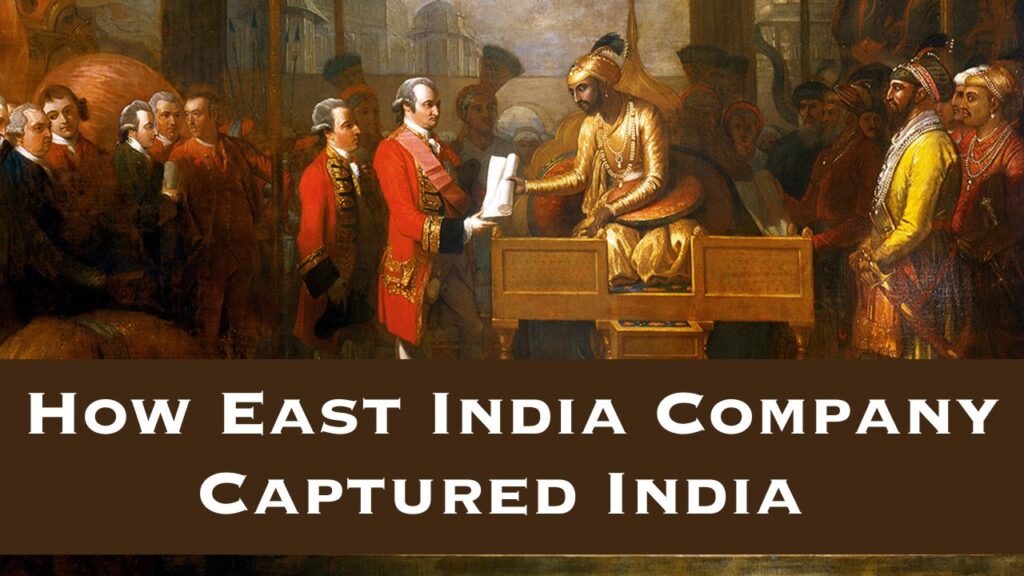How East India Company Captured India
How India was Looted by a Private Company: The East India Company
Next time you watch a Hollywood movie where a British hero fights against Hitler, remember that the cost of that fight was taken from your ancestors. When you see a monument from the West, ask yourself how the history of India changed from 1765 to 1945.
The arguments made by business houses about their models and success were just a reflection of the times. The West talks about free trade, but conveniently leaves out the Cambridge Economic History of India. The fact that the district administrative officer is still called a collector is shocking. The modern capitalist system is based on the loot of the Britishers. India was not colonized by the British, but rather enslaved by a private company. How could a company with only 125 people make such a large country a slave? Many people don’t know the actual story of how India was looted by the East India Company and later bought by an Indian, Sanjeev Mehta. Understanding this history will enable you to have informed discussions anywhere in the world.
The Birth of the East India Company
It all started in 1599 when spices, particularly black pepper, were highly valuable commodities. Dutch control over the spice trade was dominant, and even Britain relied on Dutch supplies. When the Dutch increased the price of black pepper, the British merchants became angry and decided to trade it themselves. On September 24, 1599, 24 rich merchants gathered and formed a company called the Governor and Company of Merchants of London, Trading into the East Indies. They collected 72,000 pounds from 125 shareholders and sought approval from Queen Elizabeth I.
The Royal Charter and Trading License
After three months, on December 31, 1599, Queen Elizabeth I granted the company a royal charter, allowing them to trade in various parts of the world. The charter gave the East India Company a trading license, similar to modern import and export licenses. The charter was valid for 15 years and restricted the company’s trading area to the east of the Cape of Good Hope and the west of the Strait of Magellan. This exclusive trading right ensured that no other English company could compete in those areas.
Powers Granted to the East India Company
To protect the company’s trading interests, Queen Elizabeth I granted them extensive powers. The East India Company had the authority to print its own money, create laws, establish its own foreign policy, run courts, impose punishments, maintain an army, and claim jurisdiction in the trading areas. These powers ensured that the company could operate smoothly and protect its profits.
The East India Company as a Joint Stock Company
Given the high cost and risk involved in trading, the Britishers formed the East India Company as a joint stock company. Investors could buy stocks in the company and receive profits when the company succeeded. The sole objective of the East India Company was to make profits for itself and its shareholders, regardless of any rules broken or losses incurred.
The East India Company’s Journey to India
The East India Company faced many challenges and took risks in its early days. In order to get workers, they resorted to kidnapping people from jails and asylums in London. They initially set sail for the Maluku Islands in Indonesia, where they encountered Spanish, Portuguese, and Dutch traders. The Dutch traders, in particular, had a strong presence in the region and the East India Company was unable to establish itself. They returned to England and made plans to try again, this time focusing on India.
In 1608, William Hawkins, a diplomat for the East India Company, reached India for the first time. At the time, India was under the rule of the Mughal Empire, which was at its peak. India was considered an industrial powerhouse, particularly in textiles. The Mughals ruled over a large part of India, divided into 12 provinces. The British, on the other hand, were a comparatively poor country.
The East India Company realized that in order to trade in India, they needed the permission and approval of the Mughals. They sent an official ambassador, Sir Thomas Rowe, to negotiate with Jahangir, the Mughal emperor. After three years of negotiations, a royal decree was issued allowing the East India Company to trade in a limited area in exchange for an annual payment.
The East India Company started its operations in India, initially focusing on trading through sea ports rather than establishing a strong presence on land. Over the next 20 years, they expanded their trading volume and strengthened their hold in the areas where they operated. By 1640, they had established factories and trading centers in various parts of India.

